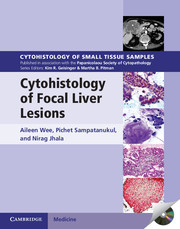Book contents
- Frontmatter
- Dedication
- Contents
- CONTRIBUTING AUTHOR
- Preface
- 1 The focal liver lesion: general considerations
- 2 Morphologic approach
- 3 Diagnostic algorithm
- 4 Focal liver lesions with low or no suspicion of malignancy
- 5 Focal liver lesions suspicious of hepatocellular carcinoma
- 6 Focal liver lesions suspicious of intrahepatic cholangiocarcinoma
- 7 Focal liver lesions from metastases and other malignancies
- 8 Focal liver lesions with cystic appearance
- 9 Focal liver lesions in infants and children
- 10 Ancillary studies
- 11 Techniques and technology in practice
- Index
9 - Focal liver lesions in infants and children
Published online by Cambridge University Press: 05 April 2015
- Frontmatter
- Dedication
- Contents
- CONTRIBUTING AUTHOR
- Preface
- 1 The focal liver lesion: general considerations
- 2 Morphologic approach
- 3 Diagnostic algorithm
- 4 Focal liver lesions with low or no suspicion of malignancy
- 5 Focal liver lesions suspicious of hepatocellular carcinoma
- 6 Focal liver lesions suspicious of intrahepatic cholangiocarcinoma
- 7 Focal liver lesions from metastases and other malignancies
- 8 Focal liver lesions with cystic appearance
- 9 Focal liver lesions in infants and children
- 10 Ancillary studies
- 11 Techniques and technology in practice
- Index
Summary
INTRODUCTION
Lest it be overlooked, not all focal liver lesions detected in childhood are tumors. Infective/inflammatory lesions and cysts have to be considered too. Most pediatric malignancies are of the hematolymphoid type and do not usually form mass lesions. Primary malignant tumors of the liver are uncommon and represent about 1.3% of all malignancies in childhood. Hepatoblastoma (HB) and hepatocellular carcinoma (HCC) are the most common primary malignant tumors of the liver and represent about two-thirds of all hepatic neoplasms. Metastases from malignancies elsewhere, for example the group of small round blue cell tumors (SRBCT), are common differential diagnoses. Tumors of the liver are infrequently aspirated in the young. In most practices, the tumors are resected rather than subjected to preoperative fine needle aspiration biopsy (FNAB) or core biopsy.
CLINICAL PERSPECTIVE
Age at presentation helps one to prioritize the list of differential diagnoses when evaluating pediatric liver masses (Table 9.1). Abdominal distension, pain, hepatomegaly, and jaundice form the major manifestations. However, certain clinical settings tend to favor one diagnosis over another – for example, intermittent jaundice with radiologic demonstration of a tumor in relation to the biliary tree in a young patient (generally <2 years) is highly indicative of embryonal rhabdomyosarcoma.
PATHOLOGIC PERSPECTIVE
Recognition of and diagnostic approach to focal liver lesions is based on pattern recognition and predominant cell profiling (Chapter 2). In keeping with this approach, a diagnostic algorithm pertaining to the characterization of focal liver lesions in the young is presented. It is based on whether the tumors are of hepatocellular, biliary, or mesenchymal derivation with specific cell profiles (e.g., cells with epithelioid features, small round blue cells, large pleomorphic cells, and spindle or giant cells) (Table 9.2).
COMMON HEPATIC TUMORS
The following descriptions will focus on common specificentities in pediatric liver tumors. This chapter will not highlight features associated with tumors, such as HCC, focal nodular hyperplasia or lesions which have been covered in prior chapters. Table 9.3 highlights some of the distinguishing cytohistologic features of selected small round cell tumors that may affect the pediatric liver.
Hepatoblastoma
This is a primary malignant blastematous tumor of the liver characterized by various combinations of several epithelial and mesenchymal cell lineages.
- Type
- Chapter
- Information
- Cytohistology of Focal Liver Lesions , pp. 234 - 249Publisher: Cambridge University PressPrint publication year: 2000

